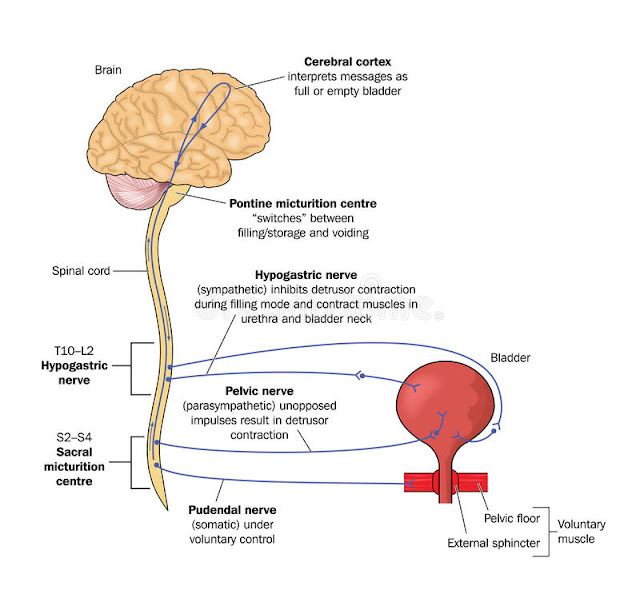Pathophysiology of Hiccups
Hiccups or Singultus are involuntary, intermittent, spasmodic contractions of the diaphragm and intercostal muscles causing sudden inspiration that ends with abrupt closure of the glottis, making a classic sound. Hiccups are called
Persistent if they last more than 48 hours and
Intractable if they last more than 2 months.
Hiccups or Singultus are involuntary, intermittent, spasmodic contractions of the diaphragm and intercostal muscles causing sudden inspiration that ends with abrupt closure of the glottis, making a classic sound. Hiccups are called
Persistent if they last more than 48 hours and
Intractable if they last more than 2 months.
Hiccups during sleep suggest an organic cause
Exact pathophysiology of hiccups is not known. The reflex arc involves
1) the phrenic nerve, vagus nerve, sympathetic chain
2) A central mediator
3) Phrenic nerve, glottis, and intercostal muscles.
The central mediator is thought to involve the respiratory centers, phrenic nerve nuclei, reticular part of brainstem, and hypothalamus. Hiccups may result from stimulation, inflammation, or injury to one of the nerves of the reflex arc.
Causes of Hiccups (Consider the reflex arc for areas of possible etiologies)
ED Management
1) the phrenic nerve, vagus nerve, sympathetic chain
2) A central mediator
3) Phrenic nerve, glottis, and intercostal muscles.
The central mediator is thought to involve the respiratory centers, phrenic nerve nuclei, reticular part of brainstem, and hypothalamus. Hiccups may result from stimulation, inflammation, or injury to one of the nerves of the reflex arc.
Causes of Hiccups (Consider the reflex arc for areas of possible etiologies)
- Gastric distention
- Carbonated drinks
- Aerophagia
- Sudden changes in GI or ambient temperature
- EtOH, Smoking
- Sudden excitement or stress
- Vagus Nerve and irritation of its branches irritation - FB ear, Pharyngitis, Neck Masses, Esophagitis, Asthma, Thoracic Aorta Aneurysm, Stomach distention, AAA, Cholecystitis, Pancreatitis, Appendicits
- Goiters, mediastinal masses, tumors can tickle the Phrenic nerve
- Diaphragm Irritation: hiatal hernia, GERD, subphrenic abscess, Myocardial ischemia, Pericarditis, manipulation during surgery
- CNS disorders: Anything that disrupts the inhibitory hiccup reflex. Can be vascular (Brainstem CVA), infectious, or structural. Consider MS, hydrocephalus, syringomyelia, masses.
- Toxic/metabolic: Can see with anesthesia, alcohol, HypoNa/Ca/K, Uremia
- Psychogenic
ED Management
A thorough history and physical. Consider investigations beased on suspected etiology and try simple remedies - Breathing into bag, swallowing sugar, forcible traction on the tongue, biting a lemon, breath holding, fright, noxious odors, ice water gargles, NG tube stimulation. Intractable hiccups may require phrenic nerve ablation.
- Medications: Address underlying cause. Options include: Chlorpromazine, Metoclopramide, Gabapentin, Baclofen, Haloperidol, low dose Ketamine.
Take Home:
- Hiccups are usually benign and involve a reflex arc involving the phrenic and vagus nerves, diaphragm, glottis, and intercostals.
- Work-up should be reserved for patients with intractable or persistent hiccups.
- Treatment modalities are varied, ranging from anecdotal techniques to phenothiazines, dopamine antagonists, anticonvulsants.
References:
- Cymet. Retrospective analysis of hiccups in patients at a community hospital from 1995-2000. J Natl Med Assoc, June 2002
- Lierz and Felleiter. Anesthesia as therapy for persistent hiccups. Anesth Analg. Aug 2002.
- Thoma, et al. Behavioral treatment of chronic psychogenic polydipsia with hyponatremia: a unique case of polydipsia in a primary care patient with intractable hiccups. J Behav Ther Exp Psychiatry. 2001 Dec
- Dobelle. Use of breathing pacemakers to suppress intractable hiccups of up to thirteen years duration. ASAIO J. 1999 Nov-Dec;45(6):524-5.
- Pelag and Pelag. Case report: sexual intercourse as potential treatment for intractable hiccups. Can Fam Physician. 2000 Aug;46:1631-2.
Posted by:
Lakshay Chanana
Speciality Doctor
Northwick Park Hospital
Department of Emergency Medicine
England


